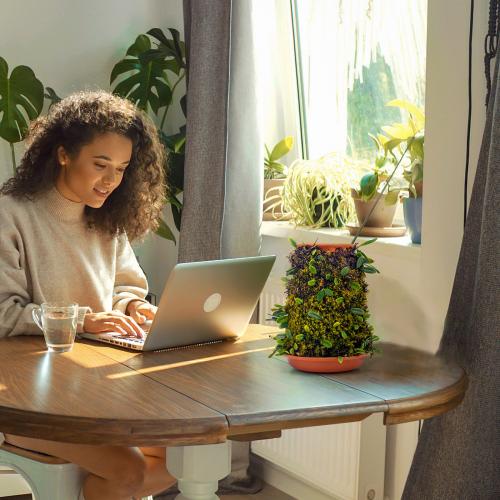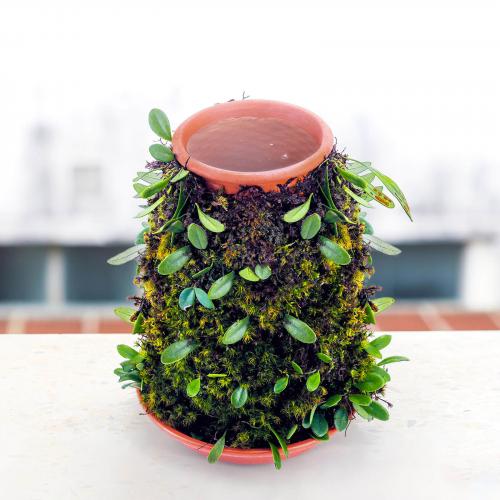|
Recent Entries to this Blog
Photinia Red Robin characteristics and most important care
Posted: 29 May 2023 Posted: 03 May 2023 Posted: 22 Apr 2023 Posted: 11 Apr 2023 Posted: 01 Apr 2023 All Entries |
How to Make the Perfect Indoor Hydroponic GardenIndoor hydroponic gardening is an exciting and innovative way of growing plants without soil. The beauty of this method is that you can grow anything you want, anywhere you want, all year round. Whether you want to grow herbs for your kitchen or vegetables for your salads, indoor hydroponic gardening is an excellent way to achieve that. In this article, we'll take you through the steps of creating the perfect indoor hydroponic garden. We'll cover everything from choosing the right plants to harvesting them. So, let's get started! 
Vertplanter pot ( photo / image / picture from AlbertoL's Garden ) A simple way to have your own hydroponic garden is with Vertplanter, a pot specially created for this type of crop. Take a moment to visit their website, then you can continue reading the post. ;) 1. Choose the Right Plants The first step in creating the perfect indoor hydroponic garden is choosing the right plants. Some plants are better suited for hydroponic gardening than others. Generally, plants that grow quickly and have shallow root systems are ideal for hydroponic gardening. Here are some examples of plants that are perfect for hydroponic gardening: ⢠Leafy Greens: lettuce, kale, spinach, arugula, etc. ⢠Herbs: basil, parsley, mint, cilantro, etc. ⢠Fruits: strawberries, tomatoes, cucumbers, etc. 2. Choose the Right System Once you have chosen the plants you want to grow, the next step is to choose the right hydroponic system. There are several different types of hydroponic systems, each with its own advantages and disadvantages. Here are some of the most popular hydroponic systems: ⢠Deep Water Culture (DWC) ⢠Drip Irrigation ⢠Nutrient Film Technique (NFT) ⢠Ebb and Flow (Flood and Drain) ⢠Aeroponics 3. Choose the Right Medium The medium you use in your hydroponic system is just as important as the plants and system you choose. The medium is what your plants will grow in and what will hold the nutrients they need to thrive. Some of the most popular hydroponic mediums include: ⢠Rockwool ⢠Coconut Coir ⢠Perlite ⢠Vermiculite ⢠Clay Pebbles 4. Choose the Right Nutrients Nutrients are an essential part of hydroponic gardening. They provide your plants with the necessary elements they need to grow and thrive. There are two types of nutrients that your plants need: macronutrients and micronutrients. Macronutrients are the elements that your plants need in large quantities, such as nitrogen, phosphorus, and potassium. Micronutrients are the elements that your plants need in small quantities, such as iron, zinc, and copper. 
Vertplanter pot ( photo / image / picture from AlbertoL's Garden ) 5. Choose the Right Lighting Lighting is crucial in hydroponic gardening because your plants won't have access to natural sunlight. Instead, you'll need to provide them with artificial light. The type of lighting you choose will depend on the plants you're growing and the hydroponic system you're using. Some popular lighting options for hydroponic gardening include: ⢠LED Grow Lights ⢠High-Pressure Sodium (HPS) Lights ⢠Metal Halide (MH) Lights 6. Choose the Right Temperature and Humidity Temperature and humidity are two essential factors that affect the growth of your plants. Most plants prefer temperatures between 65-75 degrees Fahrenheit and humidity levels between 50-70%. It's essential to monitor and maintain the temperature and humidity levels in your hydroponic garden to ensure your plants grow properly. 7. Maintaining Your Hydroponic Garden Once you've set up your hydroponic garden, it's important to maintain it properly. Here are some tips for maintaining your hydroponic garden: ⢠Monitor pH Levels: pH levels are crucial for the growth of your plants. It's essential to monitor and adjust the pH levels in your hydro ponic system regularly. The ideal pH level for hydroponic gardening is between 5.5 and 6.5. You can use a pH testing kit to check the pH levels of your water and adjust it accordingly. ⢠Monitor Nutrient Levels: Just like pH levels, nutrient levels are also crucial for the growth of your plants. You should regularly check the nutrient levels in your hydroponic system and adjust them accordingly. You can use a nutrient testing kit to check the nutrient levels in your water and adjust it according to the needs of your plants. 8. Prune Your Plants Pruning is an essential part of hydroponic gardening. It involves removing any dead or damaged leaves, stems, or roots from your plants. Pruning helps to improve the overall health and growth of your plants. 9. Harvest Your Plants Harvesting your plants at the right time is crucial for getting the best yield. Make sure to harvest your plants when they are fully mature. You can use a harvesting tool to remove your plants from your hydroponic system. 10. Clean Your Hydroponic System Regularly cleaning your hydroponic system is important to prevent the buildup of algae and other harmful bacteria. You should clean your system at least once a month using a mild soap or bleach solution. Conclusion Indoor hydroponic gardening is a fantastic way to grow your own herbs, vegetables, and fruits all year round. By following the steps outlined in this article, you can create the perfect indoor hydroponic garden. Remember to choose the right plants, system, medium, nutrients, lighting, and temperature and humidity levels. Additionally, make sure to maintain your hydroponic garden properly by monitoring pH and nutrient levels, pruning your plants, and cleaning your system regularly. With a little bit of effort and patience, you can enjoy a bountiful harvest of fresh, healthy produce from your indoor hydroponic garden. Last edited: Mon Apr 17, 2023 7:21 pm This blog entry has been viewed 170 times
You're reading one of many blogs on GardenStew.com.
Register for free and start your own blog today. Login or register to leave a comment. |
|
